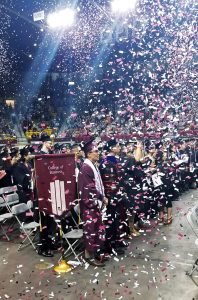By: Linda Fresques, 575-646-7416, lfresque@nmsu.edu
 |
Nothing makes a celebration more festive than confetti—especially at graduation time. This year, graduates and their guests were treated to a dazzling rain of crimson and white bits in Pan-American Center.
Some serious engineering made the gaiety possible.
Aggie Innovators who work at the College of Engineering Aggie Innovation Space (AIS) built five new confetti cannons throughout the spring semester. Led by Anthony Rendon and assisted by Jacob Flores, both electrical engineering students, along with mechanical engineering students Jordan Glaze, Drew Cassidy and Arturo Dominguez, the students put approximately 100 man-hours into the project.
The students got involved through the recommendation of Steve Stochaj, electrical and computer engineering professor, who was challenged to come up with a better design after chiding commencement staff about the hand-held confetti cannons used at the fall commencement.
As a member of the faculty advisory board of AIS, Stochaj is familiar with the type of work performed by the AIS Innovators, who advise and assist their fellow engineering students on capstone projects, among other things.
Stochaj received the backing of Bernadette Montoya, vice president of student affairs and enrollment management. “It was really nice to receive trust from that level of administration,” he said.
Safety was of paramount concern, said Stochaj who advised the students working on the cannons. “You’re working with high pressure, so the students researched the maximum pressure that could be used and halved that for the operating pressure.”
“We produced several iterations for this project,” said Rendon. “There were in total five cannons that were built — one was used for testing and was phased out and there were four final confetti cannons that were used on graduation day.”
There were three major challenges the students had to tackle: developing a device that was safe to use indoors, ensuring it would hold pressure, and selecting a release mechanism that would allow the pressure to be released.
“Our design was based on compressed air in a tank that would be held back by a valve that could be opened when we want to shoot off the confetti in barrel. Since we were dealing with pressure higher than 80 psi we needed to ensure that our tank wouldn’t rupture and cause injuries to the students and attendees of the ceremonies.”
Another challenge was keeping the cannons pressurized throughout the length of the ceremonies.
The tanks would hold pressure for about 30 minutes before leaks occurred. This was solved by simply bringing the cannons to the floor of Pan-Am approximately 30 minutes before the fight song was going to be played at the end.
“Last, we needed to ensure that the pressure could be released fast enough to shoot out the confetti to the appropriate height and distance. The valve that would release the pressure went through many iterations and ultimately ended up being a simple hand-operated ball valve,” Rendon said.
“They started out using electronic valves, but went to manual valves. It was simpler, cost less and the manual valves are reusable and don’t require batteries,” said Stochaj. “The students learned how to take a concept and come up with a design that met the needs of a customer and also cost restraints.” The cannons were funded by the Klipsch School of Electrical and Computer Engineering.
The purpose of the Aggie Innovation Space is to offer students learning experience beyond the classroom, giving them opportunities to apply theory. “Our Innovators are great problem solvers and as engineers, they seek opportunities to challenge their creativity, especially when they can see the outcome of their efforts,” said Patricia Sullivan, Associate Dean for Outreach in the College of Engineering.
“There were several mechanical engineering skills that were needed to determine if the tank would be big enough to have enough pressure to push out the confetti at a high enough velocity to achieve the spread that was desired,” said Rendon. “There were also a lot of general prototyping and construction skills — one thing that we pride ourselves on is being able to build things. Often, students are able to perform calculations and come up with a proof of concept but actually creating a product or prototype is where they fall short. I think the confetti cannons were successful because we have the experience and knowledge of how to use the resources that can be obtained at a local hardware store and turn them into a working product.”
The whole team was enthusiastic and inspired by creating something that would benefit the university. In addition, a lot of us had friends participating in the ceremonies which was extra motivation to ensure that they would have a positive experience when celebrating their achievements. One moment that was extremely memorable was having the successful shooting of the confetti during the morning ceremony. We all had some doubt in our mind that they would perform as expected. Once the fight song came on and the confetti cannons worked better than expected we were all ecstatic,” said Rendon.
The AIS Innovators weren’t the only ones pleased with the result. Student Affairs and Enrollment Management Event Planner Marisela Marquez said, “This is what we have been wanting for a long time, a big celebration for the graduates”!
